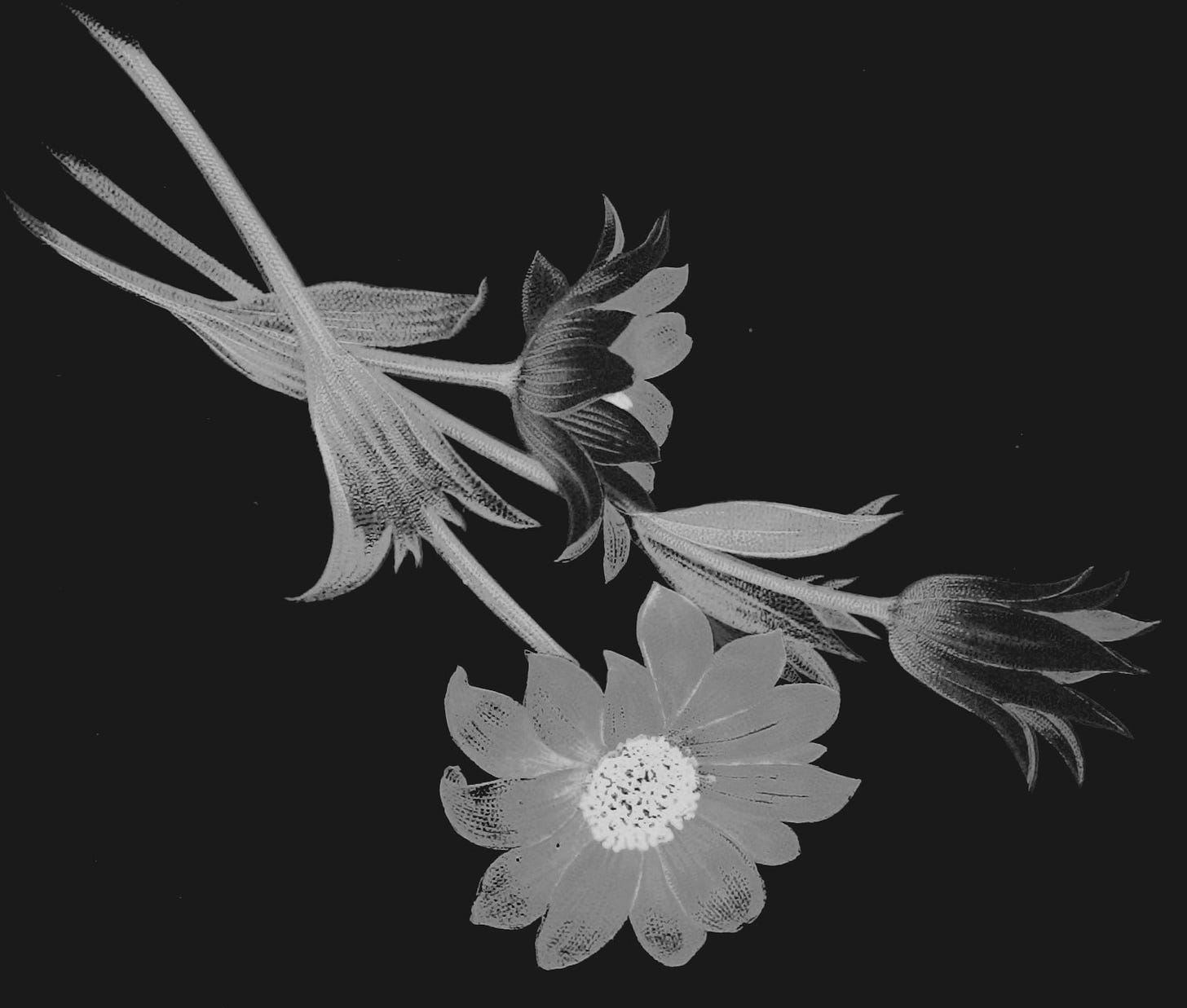I have hired a group of travelers to collect a certain ingredient, only found in areas far from civilization…
Wailing Flowers
Wailing Flowers are parasitic, and the trees from which they hang always end up dead.
They can be found in different environments, where life-threatening hazards, for humanoids and animals, are hidden. But they proliferate in damp, dark places, and are common in swamps obscured by dense vegetation and nearby mountains.
They follow sound and light, and they extend or recoil in their presences.
They have a black center, and their petals are iridescent, shifting from green to purple.
Their life-cycle is alien to other flowers; every full moon, half of the flowers bend their petals in a spiral and their center swells, transforming itself into a black fruit with purple strips. The transformed flowers fall, and their spiraling petals move to direct their flight.
When the black fruits fly in the sky, the wailing flowers begin to sing and scream, moving their petals as if they were twitching violently.
Rumors, tales, and testimonies
Wailing Flowers feeds on the souls of the wounded who fall to earth, taking their last breath as food.
That is why these flowers are more common in places that are dangerous, and their presence may indicate a hidden danger. Thus, the harvester of the wailing flowers’ fruit knows to look for them in places that are obviously dangerous, but shies away from them when they find them in places that do not appear to be so, using the flowers as signs of hidden dangers.
The fruit is the vessel of fragments of the souls of those who died at the flowers' feet, but despite this, they are a highly sought-after fruit. It appears to me that their flavor, and the ecstasy they produce when consumed, kills the memory of any knowledge or superstition surrounding the origin of their flavor, or at least makes people deaf to these facts.
However, eating too much of these fruits has its effects. People that do so have said to hear the voices of the dead appear in their thoughts and dreams, but any number of these occurrences are dismissed as the consequences of melancholia or other emotional estates afflicting the soul.
Alchemical uses:
The first step to work with these flowers, and their fruits, is to free any fragment of soul within them. For this, they must be sublimated, and let the air in them escape and condense in a cold glass tube. This condensation must be guided into a pot with mercury. Pressure and heat must then be applied to this mixture, causing it to turn into a flame. The souls will take as ethereal bodies the air around the flame, allowing them to escape, drifting away.
The flower or fruit, now free from spirits, can be used to multiply the quantity of substances, or the potency of their effect. Any digestible potion can be empowered in this way by letting the fruit or flower dip for one day in them. The fruit will double the potency of the potion, and the flower will double its quantity.
Other uses of this plant are known in necromancer circles. One of them, using the fruit clean of spirits, speaks of a head-sized vessel, made from the dried fruit, clay and silver dust, which when filled with the blood of an animal will trap its soul in the vessel. Other stories speak of various uses of these fruits to preserve one's life by eating the souls and memories of others. All very dangerous endeavors.
Chiloe’s folklore:
The “Wailing Flower” is loosely based on the “Coñeima”, and although the coñeima is associated with fortune, and may be equivalent to the goddess of minerals in other mythologies, I preferred to give it a darker theme and aura. In fact, the only thing they both share is the crying and its relation to lunar cycles.
COÑEIMA: f. Flower that inhabits the trunks of larches and cypresses. When it opens at new moon, it cries like a creature. Variation: coñieuma, cuñeima. Meaning: “miracle child”
“Among the farmers chosen by fortune, the luckiest can find, once in his life, inside one of its trunks, a flower of dazzling beauty similar to a lily: It is the mother, which, opening wide its four white petals, reveals in her bosom another smaller flower, with luminous golden petals, which projects a soft light in the gloom of its hiding place; it is the daughter, who, as a defense, exhales a nauseating odor, to keep away the intruder who observes her; however, he experiences such fascination, that he remains in ecstatic admiration of her. Soon another surprise is added to this marvelous vision: the small flower, beautiful and delicate (it is like a beautiful doll, my informants affirmed), starts a series of movements, emitting sonorous cries, identical to those of a newborn baby. Immediately afterward, both disappear.”
Chiloé Mitológico, Dr. Bernardo Quintana Mansilla.




